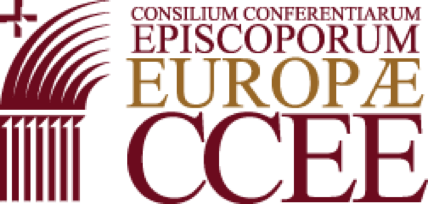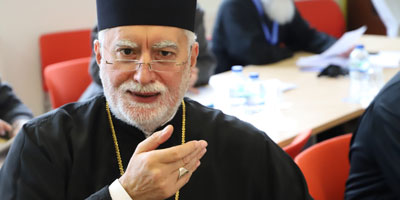The annual meeting of Europe’s Eastern Catholic Bishops begins this afternoon, Thursday 14 June (at 1700), with the solemn celebration of Vespers in the Cathedral of Saint Nichoas of Myra. Along with the local community, more than 50 Eastern Catholic Bishops will participate in the subsequent opening session which will include interventions from Cardinal Leonardo Sandri, Prefect of the Congregation for the Oriental Churches, Cardinal Angelo Bagnasco, President of CCEE, and His Grace Mgr Emil Paul Tscherrig, Apostolic Nuncio to Italy.
This year’s meeting is taking place in Lungro (Italy), at the invitation of His Lordship Mgr Donato Oliverio, Bishop of the Catholic Eparchy of Lungro degli Italo-Albanesi [Italo-Albanians] of continental Italy.
“The more our Eastern Catholic Churches are themselves, the more incisive will be our witness. The more visible is our adherence to the Christian East, the more fruitful and valuable will be our complementarity as regards the Western tradition and they will be able to make more evermore present in the heart of the Church the treasure of the Christian East”. These are the challenges identified “in the spirit of the Second Vatican Council and in harmony with the Code of Canons of the Oriental Churches”, said His Lordship Mgr Donato Oliverio, Bishop of the Catholic Eparchy of Lungro degli Italo-Albanesi of continental Italy, in outlining the aims of the meeting opening this afternoon in Lungro.
“This meeting in preparation for the first centenary of the Eparchy (13 February 2019) constitutes an event of undoubted importance because all the leaders of the Eastern Catholic Churches in Europe are gathered together, once again, to better understand what the universal Church expects from the Eastern Churches in full communion with the Apostolic See”. According to Mgr Oliverio, “these meetings enrich us all and strengthen us as Eastern Catholic Churches precisely in the commitment to identify even better our specific contribution, our identity in the ecumenical framework, with the wish that this can encourage the overcoming of misunderstandings and tensions”. For the Eparchy of Lungro, in fact, “a clearer awarness and clearer complementarity of our ecclesial identity can facilitate the precise ‘placement’ of the Eastern Catholics in the ecumenical framework”.
The meeting will continue throughout 15-16 June with interventions about the figure of the Bishop, especially with regard to some elements of the new marriage process; and the liturgy, its renewal in faithfulness to the identity of the Eastern Catholic Churches and how it renews the life of men and women. Other issues to be considered are the particular characteristics of the identity of an Eastern Catholic Church; the particular inter-eparchial law, and the contribution of the Italo-Albanian Church to the ecumenical journey.
The programme and themes of the subsequent sessions are available on the CCEE website (www.ccee.eu).
The meeting, with the participation of bishops and clerics representing 12 Eastern Catholic Churches in Europe, will be marked by the daily celebration of the Divine Liturgy (Eucharist), testifying to the richness of the different liturgical traditions in the Catholic Church.
The meeting is facilitated by the Council of European Episcopal Conferences (CCEE).
The meeting will end on Sunday 17 June with the celebration of the Divine Liturgy in the Cathedral of Saint Nicholas of Myra.
—————-
Information for journalists
The meeting is behind closed doors apart from the introductory session on 14 June, which will take place in the Cathedral of Saint Nicholas of Myra in Lungro. Interviews can be arranged during the breaks, by contacting Thierry Bonaventura – Mobile: +41788516040- Email: bonaventura@ccee.eu
A news release will be published at the end of the meeting on 17 June. The full programme and list of participants is available at: www.ccee.eu
The meeting will take place at Hotel Ariha (Via Marconi, 59 – 87036).
Within the Catholic Church there are particular Churches, called sui iuris Churchesor Rites, in full communion with the Church of Rome but distinguished from the Latin Catholic Church by their different forms of liturgical worship and popular devotion, sacramental (administration of the sacraments) and canonical (juridical norms) disciplines, terminology and theological traditions.
List of thesui iurisChurches present at the meeting
- Italo-Albanian Church of Italy(dioceses of Lungro and Piana degli Albanesi, in Italy)
- Byzantine-Slavic Rite Church in Bulgaria
- Greek-Catholic Church in Belarus
- Greek-Catholic Church in the Czech Republic
- Apostolic Exarchate for Byzantine Rite Catholics of Greece
- Greek-Catholic Church in Kazakhstan
- Greek-Catholic Church of Mukačevo
- Greek-Catholic Church in Romania
- Greek-Catholic Church in Serbia and Montenegro
- Greek-Catholic Church in Slovakia
- Ukrainian Greek-Catholic Church(Ukraine, Greta Britain and Ireland, Germany, Italy, Ukrainian communities throughout the world)
- Greek-Catholic Church in Hungary
- Melkite Greek-Catholic Church
- Armenian Catholic Church (Europe)
- Syro-Malabar Church in Great Britain
- Church of the Syro-Catholics in Europe
The first meeting took place in 1997 in the diocese of Hajdúdorog (Hungary) and was promoted by Cardinal Achille Silvestrini, then Prefect of the Congregation for the Oriental Churches, who wanted to create a space where the bishops of those churches which had been partcularly affected by atheist regimes, “may find with ever greater clarity their role in today’s Europe and be loved and respected for their history of loyalty to the Church and to the Pope, paid at a dear price” (from Cardinal Achille Silvestrini’s Introduction to the Acta of the first meeting). Since 2009, these meetings have been faciltated by CCEE.
The news release is available in English, French, German, Italian and Ukrainian.

